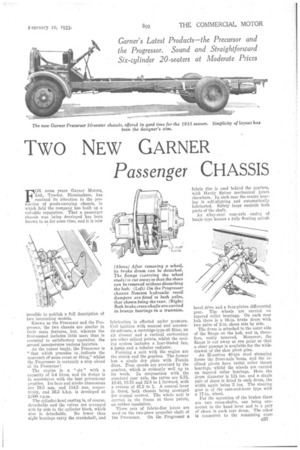TWO NEW GARNER Passenger CHASSIS
Page 87

Page 88

If you've noticed an error in this article please click here to report it so we can fix it.
fabric disc is used behind the gearbox, with Hardy Spicer mechanical joints elsewhere. In each case the centre bearing is self-aligning and automatically lubricated. Safety loops encircle both parts of the shaft. An alloy-steel rear-axle casing of banjo type houses a fully floating spiral possible to publish a full description of two interesting models.
Known as the Precursor and the Progressor, the two chassis are similar in their main features, but, whereas the first-named includes little more than is essential to satisfactory operation. the second incorporates various luxuries.
As the names imply, the Precursor is "that which precedes to .indicate the approach of some event or thing," whilst the Progressor is certainly a step ahead of its Precursor !
The engine is a " six " with a capacity of 3.4 litres, and its design is in accordance wit]i the best private-car practice. Its bore and stroke dimensions are 79.5 ram. and 114.5 mm. respectively, and 56.5 b.h.p. is developed at 2,1100 r.p.m.
The cylinder-head casting is, of course, detachable and the valves are arranged side by side in the cylinder block, which also is detachable. No fewer than eight bearings carry the crankshaft, and lubrication is effected under pressure. Coil ignition with manual and automatic advance, a cartridge-type oil filter, an air cleaner and a vertical carburetter are other salient points, whilst the cooling system includes a four-bladed fan, a pump and a tubular radiator.
Forming a unit with the engine are the clutch and the gearbox. The former has a single dry plate with Ferodo discs. Four speeds are provided by the gearbox, which is evidently well up to its work. In conjunction with the standard rear axle, the ratios are• 5.75, 10.45, 18.75 and 32.8 to 1 forward, with a reverse of 47.3 to 1. A central lever is fitted, both chassis being arranged for normal control. The whole unit is carried in the frame at three points, on rubber insulation.
Three sets of fabric-disc joints are used on the two-piece propeller shaft of the Precursor. On the Progressor bevel drive and a four-pinion differential gear. The wheels are carried on tapered roller bearings. On each -rear huh there is a 16-in. brake drum with two pairs of 2-in, shoes side by side. The drum is attached to the outer side of the flange on the hub, and is, therefore, easily removed. Moreover, the flange is cut away at one point so that a clear passage is available for the withdrawal of the shoe pivot pins.
An H-section 40-ton steel stamping forms the front-axle 'beam, and the inclined pivots have radial roller thrust bearings, whilst the wheels are carried on tapered roller bearings. Here the drum diameter is 13i ins, and a single pair of shoes is fitted in each drum, the width again being 2 ins. The steering gear is of the cam-and-lever type with a 17-in. wheel.
For the operation of the brakes there are two cross-shafts, one being connected to the hand lever and to a pair of shoes in „each rear drum. The other is connected to the remaining rear brake shoes, to the front shoes, to the pedal and to a Marelli vacuum unit. An interesting point is that the crossshafts are carried at each end in bronzebushed trunnions, mounted in the frame so that they are self-aligning. A single nipple is employed for the lubrication of the two shaft bearings, and the two trunnion bearings on each side.
Each side-member is quite straight, except for the drop of the front dumbirons, and the maximum section is 6i ins. by 2 ins. by / in. The top of the frame is entirely level.
Over the rear axle there is the wellknown Garner arrangement of two diagonal crossed stays. Besides these, there are several tubular cross-members of 24 ins. diameter. All four springs are half-elliptic, those at the rear being undershing. The brackets are attached to the frame by bolts which are a driving fit in rearnered holes. On the off side is a 22-gallon cylindrical fuel tank.
Amongst the chief chassis dimensions are the following :—Wheelbase, 13 ft. 8 ins.; track, 5 ft. lk in.; overall length, 21 ft. 3 ins.; width over hub caps, 6 ft. 11. in. ; maximum (legal) overhang, 6 ft. 4 ins.; frame height (laden), 2 ft. 2 ins. The body space available is such that 20 seats can be arranged with 30 ins, to each row.
On the Precursor, detachable steeldisc wheels carry 32-in. by 6-in. India heavy-service truck-type tyres, but giant heavy-duty tyres of the same nominal dimensions can be fitted at extra cost and are standardized on the Progressor. The rear wheels are twins. Both models have 12-volt C.A.V.Lucas starting and lighting equipment with five lamps, Tecalemit
oil-gun lubrication and a gearbox-driven speedometer.
The Progressor has, in addition, Newton hydraulic recoil dampers on both axles, a gearbox-driven tyre pump, angle-steel body outriggers built into the chassis and a front bumper bar. Its oil-gun nipples are grouped together, the speedometer has a trip mileage recorder and the headlamps dip.
Costing 1395, the Precursor is intended to carry 20 seated passengers, four standing and a driver, in a body not exceeding 25 cwt. The Progressor, which costs £465, will carry the same number of passengers, but it can be equipped with a body weighing 30 cwt.




































































































































































